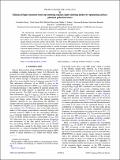Enhanced light emission from top-emitting organic light-emitting diodes by optimizing surface plasmon polariton losses
Abstract
We demonstrate enhanced light extraction for monochrome top-emitting organic light-emitting diodes (OLEDs). The enhancement by a factor of 1.2 compared to a reference sample is caused by the use of a hole transport layer (HTL) material possessing a low refractive index (∼1.52). The low refractive index reduces the in-plane wave vector of the surface plasmon polariton (SPP) excited at the interface between the bottom opaque metallic electrode (anode) and the HTL. The shift of the SPP dispersion relation decreases the power dissipated into lost evanescent excitations and thus increases the outcoupling efficiency, although the SPP remains constant in intensity. The proposed method is suitable for emitter materials having isotropic orientation of the transition dipole moments as well as anisotropic, preferentially horizontal orientation, resulting in comparable enhancement factors. Furthermore, for sufficiently low refractive indices of the HTL material, the SPP can be modeled as a propagating plane wave within other organic materials in the optical microcavity. Thus, by applying further extraction methods, such as microlenses or Bragg gratings, it would become feasible to obtain even higher enhancements of the light extraction.
Citation
Fuchs , C , Will , P-A , Wieczorek , M , Gather , M C , Hofmann , S , Reineke , S , Leo , K & Scholz , R 2015 , ' Enhanced light emission from top-emitting organic light-emitting diodes by optimizing surface plasmon polariton losses ' , Physical Review. B, Condensed matter and materials physics , vol. 92 , no. 24 , 245306 . https://doi.org/10.1103/PhysRevB.92.245306
Publication
Physical Review. B, Condensed matter and materials physics
Status
Peer reviewed
ISSN
1098-0121Type
Journal article
Description
This work was funded by the European Social Fund and the free state of Saxony through the OrganoMechanics project. Support from the excellence cluster “cfaed” is gratefully acknowledged.Collections
Items in the St Andrews Research Repository are protected by copyright, with all rights reserved, unless otherwise indicated.

